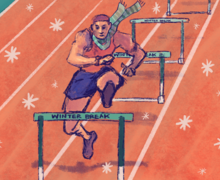In the film-session era, Syracuse watches itself less and less
Audra Linsner | Assistant illustration editor
Syracuse players may study themselves on film less than most, or all, big-time Division I teams in the country, Jim Boeheim said.
As a guard for the Orange — first as a walk-on, then as a starter — Jim Boeheim was required to watch games on an old whirring projector. Players were asked to study what had gone on with the SU defense, the offense and the transition game. The idea of long hours watching film, then in the form of cassette tapes, centers on the notion that players gain a better understanding of where they could improve.
Yet during Boeheim’s playing career, nobody closely analyzed the film.
“You don’t pay attention that much once you get about 10 minutes in,” Boeheim said in his office. He looked to his left at the Orange practice court. He sighed.
“I know I didn’t when I was playing.”
Syracuse (4-2) players may study themselves on film less than most, or all, big-time Division I teams in the country, Boeheim said. This is an era in which high school and college basketball players are often given iPads to study film between classes and on long bus rides. Advances in video technology have made film-study easier than ever: With one or two clicks, players can watch hours of game tape. And yet Syracuse players are studying film less and less.
Across the high-level sports world, video and recent developments in video and motion-sensor technology are becoming mainstream. Video functions as mental training for athletes and, combined with mental imagery, frequent video sessions develop skill, according to Jim Taylor, a sports psychologist and author of a mental preparation book. Taylor recommends athletes study video of themselves playing well to boost confidence and reinforce positive habits.
Syracuse coaches watch between 14 and 20 hours of tape each week on the opponent, said SU assistant coach Gerry McNamara, who splits up most of the film-watching duties with fellow assistant Allen Griffin and associate head coach Adrian Autry. Video coordinator Todd Blumen handles the logistics.
While they do the bulk of the legwork, players watch some tape: Freshman guard Buddy Boeheim, for example, started watching film in third grade. He said film can still be meaningful to correct flaws. Senior point guard Frank Howard is the team’s strongest pro-film advocate, using the practice to learn opponent tendencies and develop his 3-point shot. He videotaped his workouts last summer and saw something he didn’t like, so he tweaked his form.

Alexndra Moreo | Senior Staff Photographer
But Boeheim doesn’t want his players spending hours glued to a screen, whether on their own or in a team video room, because he doesn’t think it’s efficient. He also fears an abundance of information, so he only shows players a few minutes of tape at a time.
Attention-spans aside, Boeheim’s chief concern with video is how it fosters selfishness. He believes players’ eyes naturally gravitate toward themselves to see how they look and how they did — not necessarily what their actions mean in the greater picture of the game.
While Boeheim said most programs study video regularly, at least one coach shares a similar philosophy: Maryland’s Mark Turgeon. He watches six to eight hours of video in scouting each opponent but shows his players only about 12 minutes, according to Hudl. Texas head coach Shaka Smart, on the other hand, has the more widely-held belief in the power of showing video to players.
“The saying is that the tape don’t lie, so it’s great to take the things that happen on the floor and slow them down,” Smart told Hudl. “Be able to pause, rewind and play a segment back over and over again and just learn, first of all as a coach, what some of the things are that we need to do better as a team, and then to be able to take individuals and groups of players and say, ‘Here’s an area where you’re doing really well. Keep doing that,’ and ‘Here’s another area that maybe we need to do a little bit differently.’”
East Carolina watches a lot of film, said Syracuse junior forward Elijah Hughes, a transfer from ECU. He’d spend hours with his former teammates studying tape, mostly in group sessions. At Syracuse, his film intake has dramatically reduced. “It’s much, much less” — several hours less per month, he said.
Sophomore forward Bourama Sidibe watches only a “couple of minutes” before every game. “If you’re watching a lot, you don’t retain anything. When we watch a short bit, we learn, we retain,” he said. Senior center Paschal Chukwu said video was a big part of Providence’s approach — he played there for one season — but it’s no longer as consistent a part of his preparation.
“As a visual learner, I have to see myself, what I’m doing right, what I’m doing wrong,” Chukwu said. “Video is important in that sense.”
Syracuse practices its patented the 2-3 zone every day. There’s no need, Boeheim said, for players to watch tape of the 2-3 when they go over the movements each practice. Teams that play man-to-man defense typically have more variations to consider. There’s more of a need to look for intricacies and study them on film, he said.
Yet even offensively, Syracuse players are required to watch a minimal amount of film. Boeheim said he and the coaching staff occasionally show players snippets of tape if they want to emphasize a particular opponent tendency, or a component of the SU offense that needs to be improved immediately. Boeheim said he may resort to film if he notices that a player isn’t hustling back on defense. If the player insists that he is, Boeheim finds video proof.
Griffin, a former SU guard, said he watches hours of film every week during the season. Then he picks up to five brief clips, the length of a possession or two, and he walks downstairs from his office in the Carmelo K. Anthony Center to the trainer’s room. He presents to Sidibe and Chukwu about five clips on his laptop.
“Just a few clips so they have something specific to focus on that day in practice,” Griffin said. “We don’t sit and watch 45 minutes of film in my office. That’s counter productive.”
McNamara, a four-year starter at guard and 2003 national champion, noted Boeheim’s film belief has remained fairly constant since his playing days. He appreciated that he didn’t have “information overload” as a player. He was shown only the information he really needed.
“Players don’t watch,” Boeheim said. “The things we see that can be changed, we fix on the court. Most players watch the tape looking at themselves to see if they made a good play. That’s what they’re looking for.”
Published on November 29, 2018 at 4:30 pm
Contact Matthew: mguti100@syr.edu | @MatthewGut21






